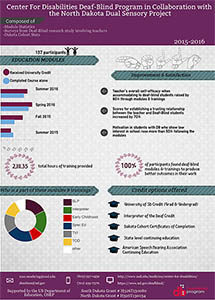Innovative Trainings in Deaf-Blindness (SD UCEDD)
February 6, 2017

|
| Download |
|
|
Children who have deaf-blindness miss out on opportunities for learning that other children receive incidentally or naturally as those without sensory impairment have access to the many sights and sounds from their environment. These missed opportunities can result in a sense of isolation from others and problems in communication skill development, concept formation, and overall learning. In the school setting deaf-blindness is considered a disability of access to the visual and auditory information provided in educational environments.
To address this need, the Center for Disabilities' Deaf-Blind Program collaborated with the National Center on Deaf-Blindness (NCDB) and North Dakota Dual Sensory Project, to develop an online training program called the Dakota Cohort Trainings in Deaf-Blindness. NCDB contributed access to 27 online training modules, developed at the direction of the US Office of Special Education Programs. A participatory approach was utilized with input and feedback from leaders in the field of deaf-blindness, such as deaf-blind program staff, teachers, para-educators, parents, and other service providers.
Modules cover numerous topics: foundational information related to deaf-blindness, enhancement of communication access, and strategies and resources for literacy development. Content is illustrated using a multimedia approach of PowerPoint presentations, videos, and assigned readings. Deaf-Blind Program staff review and respond to assignments, enabling participants to obtain a wide variety of credit options at a low cost. The overall goal is to help teachers meet the educational needs of students that have deaf-blindness and to better prepare persons with dual sensory impairment for adult life.
Particpants have come from a wide variety of backgrounds in both rural and urban areas, including special education teachers, speech language pathologists, teachers of the deaf and hard of hearing, teachers of the visually impaired, interpreters, and para-educators. To date, courses have been offered for five semesters with approximately 200 participants from South Dakota, North Dakota, and Wyoming. Most are in pursuit of university graduate level credits while others obtain continuing education credits to satisfy requirements of national certifying agencies such as the Registry of Interpreters for the Deaf (RID), American Speech-Language-Hearing Association (ASHA), as well as state recertification.
One training participant commented "I learned tools and methods that will make me a better educator for every student. I especially enjoyed the discussions that occurred between the participants, as well as the activities that required us to share our ideas and questions with colleagues, even if they were not enrolled in the modules. I'm sure we learned as much from each other as we did from the material itself."
Dakota Cohort trainers were fortunate to be able to present this educational model at the 2016 Project Directors meeting in Washington, D.C. Staffers look to expanding to other areas of the country, through a more formalized process for training of both para-educators and teachers, and for interested participants from other regions of the country.







